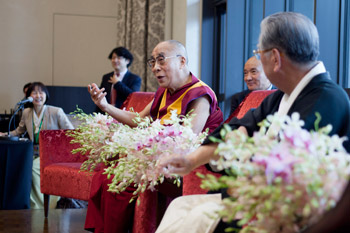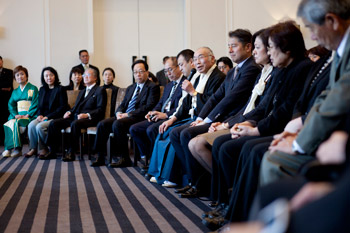Sendai, Japan, 8 April 2014 - After the formal air of yesterday’s purification prayers and His Holiness’s public talk, today there was an opportunity for easier interaction between him and Shinto followers from many walks of life. After brief introductory speeches an elderly man offered His Holiness a framed calligraphy of the Japanese character for ‘peace’ along with a flyer he said he has been distributing to promote peace in the world.
In his opening response, His Holiness told the gathering that he was honoured and happy to meet with members of the Shinto community. He cautioned that he had nothing special to say, but began to explain his three commitments.

|
His Holiness the Dalai Lama speaking to Shinto followers during their meeting in Sendai, Japan on April 8, 2014. Photo/Office of Tibet, Japan
|
“As a human being, I believe each one of us should have some concern for others and for the planet. I am also dedicated to promoting inter-religious harmony. Wherever I go I try to hold discussions with members of other religious traditions, because it is important to get to know about them. It’s important to meet people who actually take the practice of these various traditions seriously. That’s why I’m interested to know more about the Shinto tradition which pre-dates Buddhism in Japan. Now, let’s have some questions and debate.”
Before the question and answer session went any further, the organizer of the event introduced a Vietnamese Buddhist who was the representative of a group who had intended to come to meet His Holiness. Their intention was deflected, however, by the recent passing away of Ven. Thich Tri Tinh, the First Supreme Patriarch of the Vietnamese Buddhist Sangha. His Holiness remarked that he has met with groups of Vietnamese who have settled in various countries such as France and noted their enthusiasm to continue their Buddhist practice and cultural traditions. More recently groups from Vietnam have begun to visit him in India too.
“Over the years I’ve met groups of Japanese quite often. I’ve taught the ‘Heart Sutra’, which is widely recited here, whether it is understood properly or not. Most of you here are Shinto followers and the impression I have is that the tradition shows great respect for nature. This is good, because modern life has become too mechanised. We seem to think that we can control and dominate nature, forgetting that we are part of it. The respect that ancient traditions like Shinto and those of the Native Americans have for the natural world has crucial lessons to teach us all today.”
A woman who described herself as a florist explained that she has noticed her skill with flowers declining as she grows older and wanted to know what she should consider most important in her life. His Holiness replied that it isn’t easy to generalise, but, as a result of our biased education system, the majority of the 7 billion human beings alive today think only in terms of material values, not inner, humane values. As interest in conventional religion declines, he said we need to take care of our inner world as well as the natural world we live in.

|
A member of the gathering of Shinto followers asking His Holiness the Dalai Lama a question during their meeting in Sendai, Japan on April 8, 2014. Photo/Office of Tibet, Japan
|
“For many people, the only tangible value is money. And of course money has its place, but the value of cultivating a compassionate attitude is much more effective. As a florist your work is involved in bringing other people pleasure. When we only pay attention to material values, there’s little room for concern for others, or for mutual regard. Some of my friends in Europe and America are very wealthy, but they are still unhappy and lonely. Their wealth fails to bring them lasting pleasure. Our physical facilities and many aspects of our modern education have improved immensely, and yet stress and loneliness prevail.”
His Holiness invited older members of the gathering to talk about ways to develop peace of mind and whether they were easier to put into effect when they were young. He asked if they felt life had become more stressful today. The elderly man who had offered him the calligraphy of ‘peace’ at the beginning answered. He said that what he’d noticed is that when he was a boy he jumped into rivers, climbed trees and collected all kinds of scrapes and scars. Child’s play involved some risk and danger, but children learned caution, what they could and could not do. They learned to look after themselves, and at the same time acquired a proper respect for nature. Nowadays, children cannot learn from experience because they don’t venture out of their houses. They don’t take risks because they are too protected.
His Holiness added to this that in modern society, out of a concern for physical health, we learn the importance of physical hygiene. Given the problems we face, many of them of our own making, he proposed the need for emotional hygiene too to help deal with destructive emotions that disturb our peace of mind. He said:
“We need to know what supports and what destroys our peace of mind. Thirty years of dialogue between Buddhist science and modern science have given rise to an organization called the Mind & Life Institute, which is examining peace of mind and conducting related research in an objective way. More and more Japanese scientists and intellectuals are taking an interest in this work too. Next week we’re holding a meeting of Mind & Life in Kyoto.
“I think our emotions today are much the same as they were a couple of thousand years ago. Buddhist science has much to teach about how to control them and prevent their disturbing our peace of mind. When I speak of Buddhist science what I really mean is ‘science of the mind’. This is something modern scientists are showing increasing interest in.”
This afternoon, His Holiness will fly from Sendai to Osaka, the largest part of the Keihanshin metropolis, which includes Kyoto, where he will spend the next several days. 